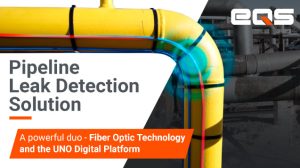Civil Engineering Testing
It is often necessary to test wood and concrete structures to determine whether the asset is suitable for its designed use. Ideally, this testing should be done without damaging the materials.
Non-destructive testing can be applied to both old and new structures and allow to remove uncertainties about the acceptability of the material, locate and determine of the extent of cracks, voids, honeycombing and similar, assess the materials’ potential durability and condition.
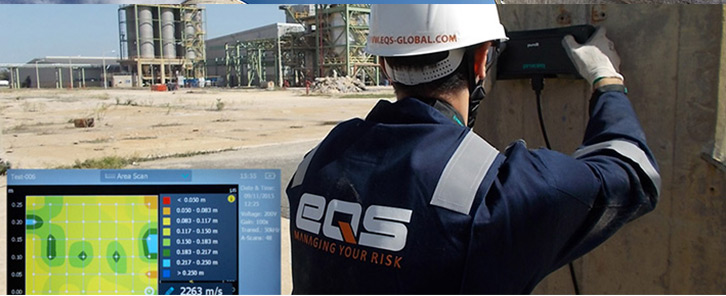
3D Ultrasonic Tomography
Ultrasound computer tomography is an innovative imaging method capable of producing volume images with both high spatial and temporal resolution. This new method avoids two-dimensional X-ray images’ limitations – instead of generating only one image in one position, a series of projections is taken under different angles, while rotating the object in the radiation beam.
3D Tomography provides an excellent means of visualization, in terms of materials’ characterization, allowing the visualization of the interior of the structure or object, not requiring the use of invasive methods.
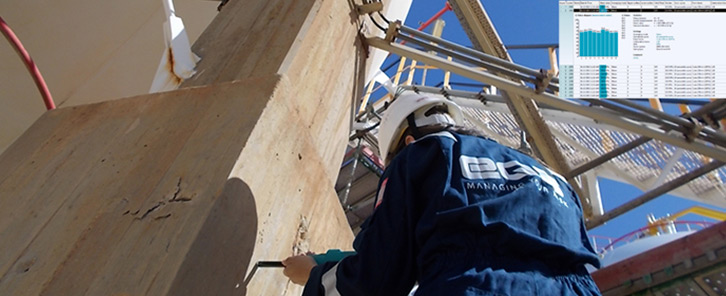
Sclerometer
Performing inspections and analysis of the structures’ compression resistance is essential. With a defined energy striker, the sclerometer strikes the concrete and rebounds according to the hardness of the concrete. Conversion Tables ( calibration curves), make it possible to reduce the compressive strength from the value of rebound, called rebound number/index.
The Sclerometer technique can be combined with ultrasound measurements(SonReb technique) and applied to existing or new structures.
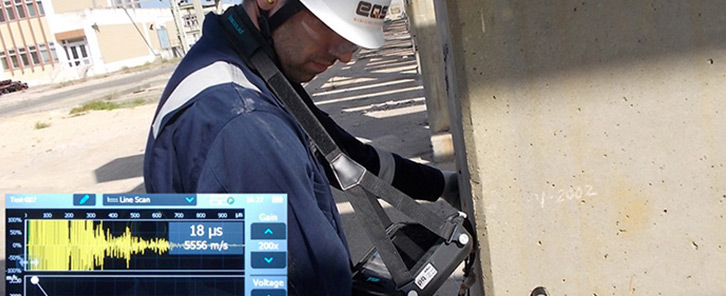
UPV – Ultrasound Pulse Velocity
Ultrasonic Pulse Velocity uses the compressive wave’s travel time, across concrete structures to recover compression wave velocity, in order to perform mechanical characterization of concrete, including modulus and compressive strength, as well as to collect geometrical information (crack depth).
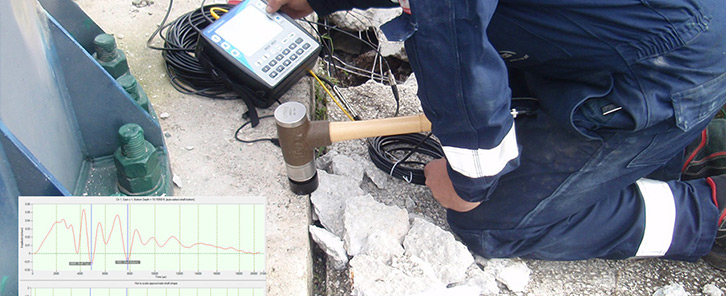
Impact-echo (IE)
The impact-echo method uses impact-generated sound stress waves that propagate through the structure and are reflected by internal flaws and external surfaces. Impact-echo transducers are extremely sensitive, broadband receiving transducers that respond faithfully to normal surface small displacements.
Designed to determine the condition and thickness of concrete, wood, stone, and masonry structural members when voids, honeycomb, and/or cracks are suspected, Impact-echo (IE) systems provide information on the depth of a flaw or defect on concrete elements accessible only by one side on the surface, in addition to mapping its lateral location and extent.
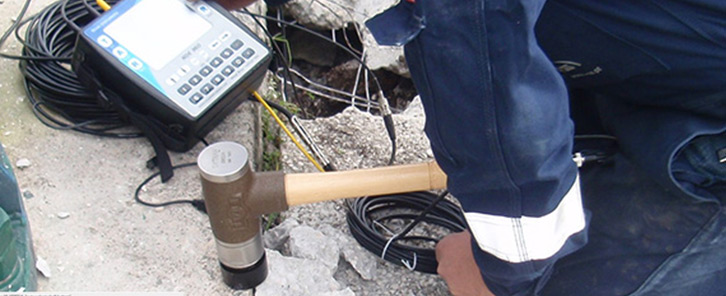
Pile Echo Test (PET)
Pile Echo Test is a measuring method used to assess structural integrity in the load-bearing elements of a building. Based on the measurement of a wave reflected inside the pile, is a user-friendly, highly flexible solution for testing a large number of deep foundations quickly and accurately.
The wave is generated inside the structural element and the reflected wave is captured and analyzed by the PET’s digital accelerometer to provide information regarding the length and shape of the pile, and whether it is intact. PET allows to assess the pile’s integrity and to locate and determine the anomalies’ extension.
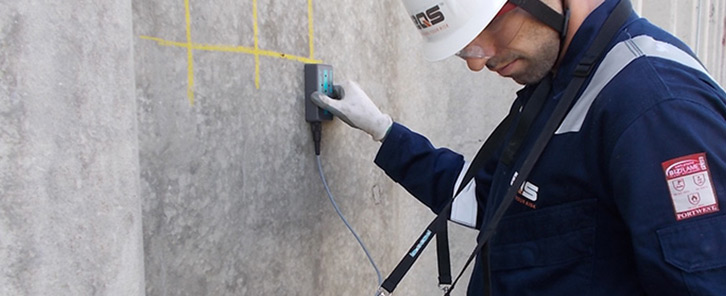
Covermeter
Locating rebars is one of the most common testing tasks in Civil Engineering. Covermeter survey is non-destructive testing, based on ferromagnetic induction principles, used to detect the location, size, and depth of the concrete elements’ reinforcement.
The testing principle is that the field of an electromagnet is affected by the presence of steel. The meter is based on a pulse-induction eddy current design and consists of two parts: a locating probe, and the meter that provides an indication giving the dimension of the cover over the steel or a signal strength reading.

Carbonation Depth
Carbonation depth measurement test used to determine whether moisture has reached the depth of the reinforcing bars and hence corrosion may be occurring, uses pH indicators to spray on fresh fractured concrete surfaces and change the color in the concrete zones with different pH.
A clear liquid turns pink in contact with the alkaline (non-carbonated) concrete and remains colorless in contact with carbonated concrete. The color change usually indicates an abrupt transition between pH.
This testing method allows us to perform durability diagnosis and life service prognostic relative to the carbonation deterioration process of concrete structures.
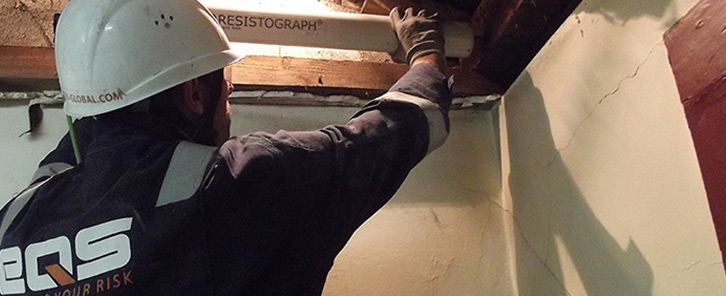
Resistograph
The Resistograph (drill resistance testing) is a quasi-non-destructive testing method, that measures the wood timber resistance to the advancement of a small diameter drill bit.
The drill is advanced at a constant speed through the timber and the recorded resistance provides a measure of the material density through the sample. Providing information at a specific location only, the Resistograph produces a real-time graph of the torque’s relative magnitude. The graphic obtained is stored in the onboard computer.

Acoustic Emissions
Acoustic emission is the occurrence of sound and ultrasound in material that undergo fracture processes and crack propagation. These acoustic waves are recorded by an AE system during monitoring. It can only be used in a passive way. AE can be used to identify the occurrence and location of damage within the monitoring period, e.g., the occurrence of a crack in the concrete. The system consists of a series of sensors placed on the surface of the structural elements to be inspected.
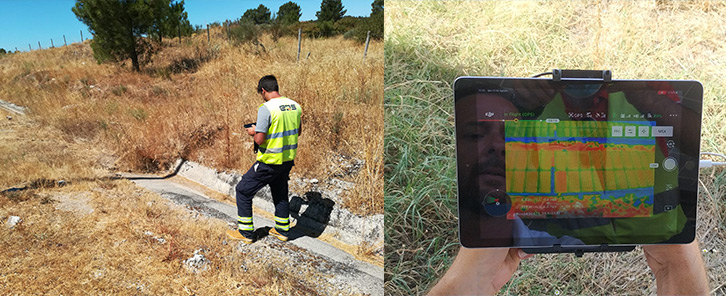
GPR – Ground Penetrating Radar
Ground-penetrating radar uses the emission of electromagnetic pulses, which reflects partially on heterogeneities or interfaces of different layers, with different dielectric properties. Specific characteristics of the radar signal (arrival time of the signal, attenuation) can also provide useful information, to obtain geometrical details, and find heterogeneities, among others.
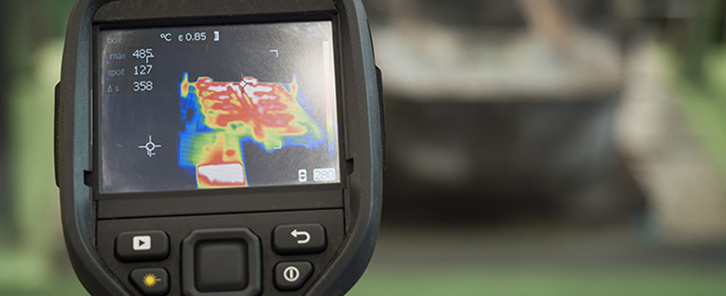
Thermography
A thermographic inspection is a technique that detects infrared radiation naturally emitted by materials, allowing temperature measurements without physical contact. By using infrared systems, it is possible to observe differences in the pattern of heat distribution in a material component, in order to provide information related to this operating/structural condition.
This method’s main objectives are to:
● Assess the integrity of concrete structures;
● Detect Thermal insulation defects/failures;
● Estimate coating thickness;
● Detect eroded areas.
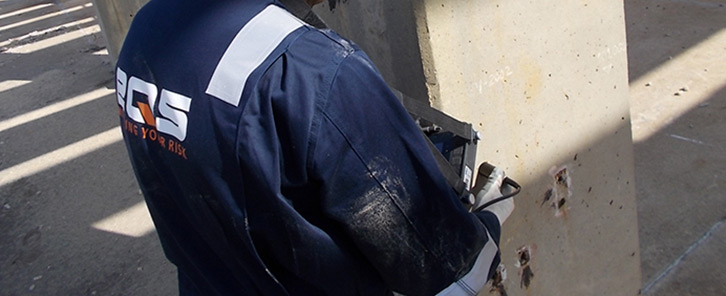
Half Cell Potential
Corrosion of steel in concrete is a global problem for concrete structures. When steels corrode, there are usually signs of deterioration on the concrete surface such as rusting, cracking, and spalling.
Half-cell potential measurements are simple, and virtually non-destructive techniques are used to estimate the corrosion risk of steel even if there are no signs of corrosion on the concrete surface, which is a significant advantage for inspecting existing concrete structures.
Corroding and passive rebar in concrete show a difference in electrical potential and current flows between these areas. The electric field coupled with the corrosion between corroding and passive rebar areas can be measured with a half-cell placed on the concrete’s surface, allowing to locate of corroding rebars.
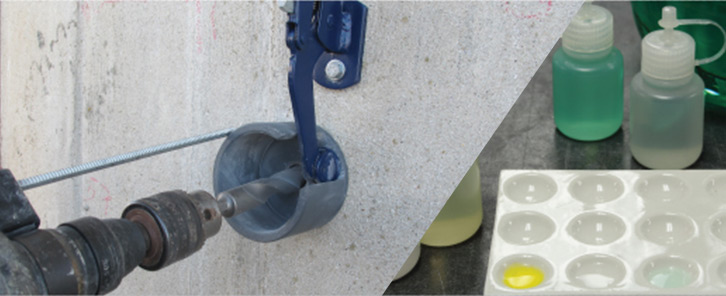
Chloride Determination Analysis
The excessive presence of chloride in concrete is great potential for corrosion of embedded rebars. Even though the chloride quantity present in concrete may be small, chlorides can increase due to the use of creek sand, saline air, seawater, and severe exposure conditions. The determination of chloride concentration allows for evaluating the need for repairs on existing structures and verifying the durability conditions of the materials used in new constructions.
Chloride determination analysis is applied in order to determine acid-soluble chlorides existing in the concrete. A dust sample of concrete is tested and dissolved in a standard acid solution. The chloride ions react with the acid in an electrochemical reaction. Chloride contamination and corrosion are measured.
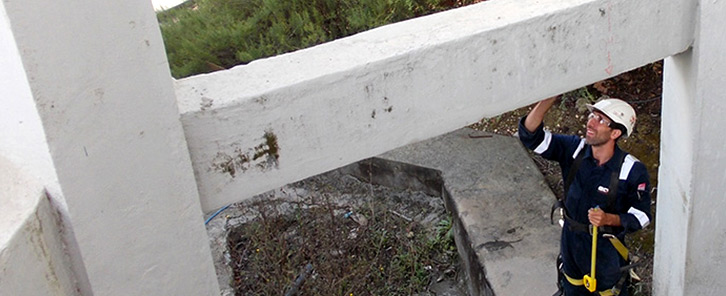
Electrical Resistivity
Concrete quality control, normally associated with the conformity verification of mechanical and durability characteristics, usually requires lengthy procedures for the specimens’ conditioning and preparation. Resistivity is often related to corrosion and protection of steel reinforcement and to durability performance of concrete
Concrete Electrical Resistivity can be measured by several means. The resistivity of cement paste, mortar, and concrete depends on the pore volume and pore-size distribution of the cement paste, the pore-water composition, and the concrete’s moisture content. These characteristics are controlled by the degree of hydration of cement paste in concrete. As a result, ER of concrete will increase with time.
ER allows evaluating the corrosion risk of reinforcement in concrete. Furthermore, resistivity is correlated with transport properties, which makes the information useful for deterioration processes involving water or transport of aggressive agents.
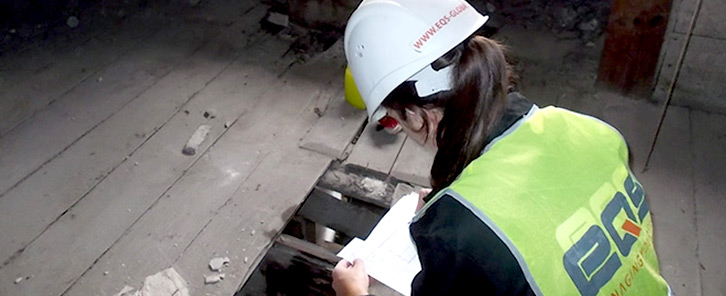
Pilodyn Penetrometer
Decaying dead wood density measurements are a useful indicator for multiple purposes, such as for estimating the amount of carbon in deadwood and making predictions of the potential diversity of dead wood-inhabiting fungi and insects.
Currently, qualitative decay phases are used as wood density estimates in many applications. Penetrometers, which are commonly used for measuring the density of standing trees, might also be applicable to deadwood density measurements.
Instant, cost-effective non-destructive testing method, the Pilodyn Penetrometer operates on the basis that a blunt pin is shot into the wood with a pre-set energy, and from the penetration of the needle, the density of the wood or the degree of decay in the wood can be assessed.
EQS Global is an accredited Third-party inspection Body, Notifed Body (NoBo), and accredited Non-Destructive Testing laboratory, offering a full range of services dedicated to inspection, and the necessary knowledge to support its clients throughout the assets’ lifecycle.
Do you want to know more? Request a Quote


